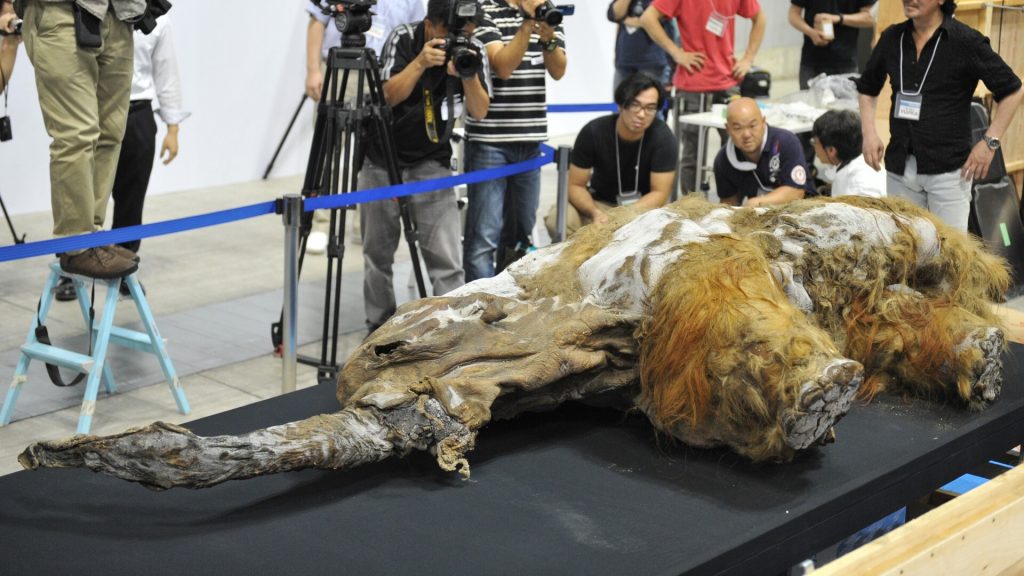What caused the woolly mammoth to go extinct? RNA may hold the answer

New research published in the journal Cell reveals that scientists have managed to extract RNA, the molecule that translates genes into proteins, from the remains of a woolly mammoth that came from the last Ice Age around 39,000 years ago. The mammoth that researchers have named “Yuka” was first found by researchers in eastern Siberia more than a decade ago.
The new RNA discovery could offer a glimpse into what led to the baby mammoth’s ultimate demise and what was happening inside the animal’s cells when it died.
Cave lions may have killed ‘Yuka’
Scientists said Yuka had evidence of scratch marks that could mean the mammoth died while being hunted by cave lions, or that the predators were scavenging its remains.
Further study of the mammoth also revealed that it was a male. Previously, scientists had believed Yuka was a female.
What’s the difference between DNA and RNA?
Over many years, researchers had studied Yuka’s DNA, which contains genes that carry the instructions for building certain proteins, but had long sought to better understand the mammoth’s RNA.
A scientist who was involved in the study said that RNA molecules tell “the cells how and when to make proteins.”
“The whole set of RNA’s contained in a cell at a given time point is very dynamic [and] can also quickly change in response to many factors, like stress, daytime, feeding, sleep, contaminants, infections, etc,” Emilio Mármol Sánchez, a geneticist at the Center of Evolutionary Hologenomics at the University of Copenhagen, told NPR.
Sánchez and fellow researcher Love Dalén, a paleogeneticist at Stockholm University, told NPR that if they could find the RNA out of the mammoth, they’d get a glimpse of the genes that were in use when the animal died.
A challenging process
However, the challenge with studying RNA is that it degrades quickly and typically survives just minutes or hours– not usually millenia– like in the case of Yuka.
“It felt like a very high risk project,” Dalén told NPR. “It seemed like a completely crazy thing to try to do.”
But both hung their hopes on some studies that have successfully discovered RNA within ancient specimens.
“So we knew that there was a chance, if we had some really well-preserved samples, to get this to work,” Dalén said.
Methodology and what scientists were able to salvage
Dalén and his research team then began collecting tissue samples from ten different mammoths, including Yuka, and undertook the meticulous process of extracting RNA. The samples were extremely small and had broken down over time. But scientists went ahead with the painstaking task of piecing the segments together, to prove that they were indeed truly RNA.
“The big bulk of the work is on the computational side to make sense of all the gigabytes of data,” Dalén said.
Most of the samples were reportedly too fragmented to determine if it was RNA, but three of the mammoths had enough material to test. That included Yuka, which scientists had sampled through muscle tissue. Scientists said the RNA from Yuka was associated with slow-twitch muscle function and development, which they hypothesized could’ve linked to some kind of stress response.
What the results revealed
“That would be consistent with an animal being chased down by cave lions, but of course there could also be other explanations,” Dalén said. “If you get stuck in the mud, your muscles would be stressed from trying to get out. So we can say that the muscles were stressed at the point of death, but we don’t really know why.”
Dalén said that it’s a groundbreaking discovery that reveals it is possible to know which genes were active in a now-extinct animal.
“You’re actually seeing the processes going on inside the cells right around the time it died,” he said. “And these processes have been frozen in time for 40,000 years.”
What does it mean for the future?
Scientists not involved in the study called the findings “fabulous in terms of all sorts of technological barriers being shattered.” They told NPR that future work with RNA in these and other mammoth specimens may provide further clues into what ultimately caused the animals’ extinction, along with how they lived and adapted to their environment.
The latest study comes as Colossal Biosciences is working to bring the woolly mammoth back and other de-extinction efforts. The company claims it has already successfully brought back the dire wolf.
Researchers say that the latest findings might not only provide hope for better understanding the lives of woolly mammoths, but further research on the evolution and rapid mutation of certain viruses.
The post What caused the woolly mammoth to go extinct? RNA may hold the answer appeared first on Straight Arrow News.





